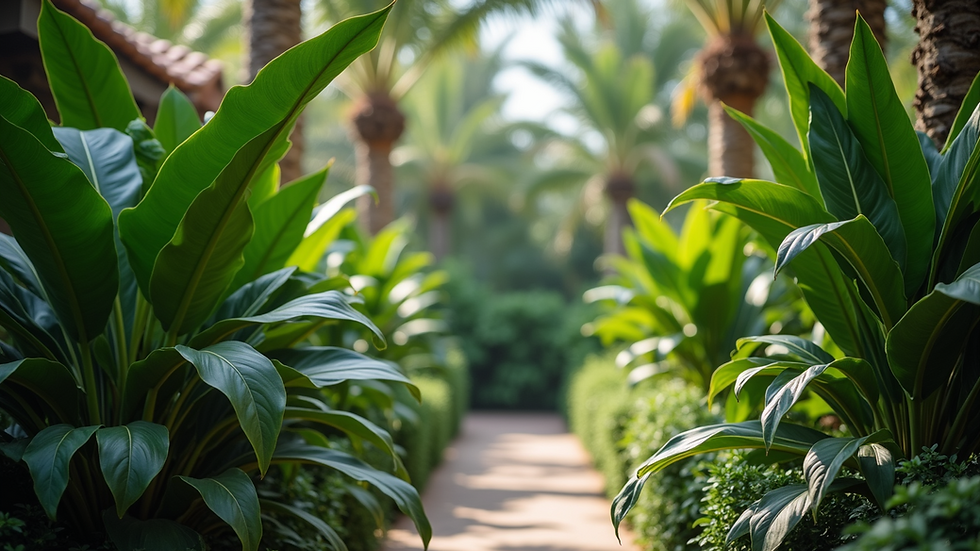How Palm Trees Can Thrive in Cooler Climates
- Brandon Hall

- May 26
- 4 min read
Palm trees evoke images of tropical paradises, sandy beaches, and warm sunshine. However, the allure of these tall, slender trees is not limited to warm climates. Many people are surprised to learn that palm trees can thrive in cooler climates too, including areas like Connecticut. Understanding how to cultivate and care for these beauties can transform your landscape, bringing a touch of the tropics to your backyard.
Connecticut Palm Trees
In Connecticut, selecting the right palm species is crucial for success. Not all palms can withstand cold temperatures, but some varieties have been specifically adapted for cooler climates. For homeowners, the most popular choices include the Windmill Palm (Trachycarpus fortunei) and the Needle Palm (Rhapidophyllum hystrix).
Windmill Palm: This palm can tolerate temperatures as low as 5°F. Its fan-shaped leaves and sturdy trunk make it an eye-catching addition to any garden. It's also relatively low-maintenance, requiring only occasional watering and protection from harsh winds.
Needle Palm: Known for its hardiness, the needle palm can survive in even colder conditions, reaching as low as -5°F. The needle palm has a unique appearance, with spiky needles along its trunk that give it a distinctive look.
By choosing the right species, you can enjoy the beauty of palms without worrying about their survival during colder winters.

Factors Affecting Palm Tree Growth
Several factors influence how well palm trees adapt to cooler climates. Understanding these can help ensure that your palm trees grow tall and healthy.
Climate Zones and Temperature
Connecticut has a variety of climate zones, ranging from USDA hardiness zones 6a to 7b. This variation significantly affects which palm species can thrive. For example, in zone 6a, homeowners might find success with the needle palm, while those in 7a could experiment with windmill palms. Monitoring local temperatures is crucial for determining which species will adapt best.
Soil Quality
The quality of the soil plays a pivotal role in the growth of palm trees. Well-draining soil is essential. Too much moisture around the roots can cause root rot, which can be fatal. Before planting, test your soil to ensure it has adequate drainage and nutrients. Mixing in organic compost can enhance soil quality and provide essential vitamins.
Sunlight
Most palms require full sun for optimal growth. Aim for at least 6 to 8 hours of direct sunlight daily. However, be cautious during extreme temperature fluctuations, as young palms may need some shade to acclimate. A location with ample sunlight will encourage healthy growth and vibrant foliage.

Planting and Caring for Palm Trees
Once you’ve selected the right palm for your climate and soil, it’s time to plant and care for them properly.
How to Plant Palm Trees
When planting, choose a well-drained area. Here’s a simple step-by-step guide for successful planting:
Dig a Hole: Make the hole twice as wide as the root ball and just as deep.
Prepare the Soil: Amend the soil with organic compost if necessary, enhancing drainage.
Position the Palm: Place your palm tree in the center of the hole, ensuring that the top of the root ball is level with the surrounding soil.
Fill the Hole: Carefully pack the soil around the roots, avoiding air pockets.
Water Generously: Immediately after planting, water the palm deeply to help it establish.
Maintenance Tips
Watering: Young palms need consistent moisture. As they mature, you can reduce how often you water. During dry spells, a deep watering can help promote root growth.
Fertilization: Apply a balanced fertilizer during the growing season to encourage growth. Be careful not to over-fertilize, which can harm your palms.
Protection from Winter: In the colder months, providing protection can help your palms survive. Use mulch around the base to insulate the roots and consider wrapping young palms in burlap during extreme weather.

Troubleshooting Common Issues
Even hardy palms can encounter problems. Here are some common issues and how to address them.
Cold Damage
While selecting cold-tolerant species is essential, winter can still cause damage. Newly planted palm trees are more susceptible to cold stress. If you notice browning or wilting leaves in the spring, it may be a sign of cold damage. Trim any dead foliage and ensure the tree is healthy before the next winter season.
Pest Problems
Like other plants, palm trees can attract pests, such as scale insects and mealybugs. Regular inspection can help you catch infestations early. If pests are found, consider using insecticidal soap or neem oil as a natural remedy.
Nutrient Deficiencies
If your palm tree shows signs of yellowing leaves, it may be suffering from nutrient deficiencies, specifically magnesium or potassium. Adding a slow-release fertilizer that includes micronutrients can resolve this issue.
Diverse Applications of Palm Trees
Integrating palm trees into your garden not only offers aesthetic value but can also serve practical purposes. Here are some ideas to maximize their presence:
Landscaping Aesthetic
Palm trees can create a lush, tropical atmosphere. Plant them in clusters or as singular focal points to provide height variation in your landscape. They can also act as natural privacy screens when planted in rows.
Climate Adaptations
Beyond their beauty, palm trees can adapt to various landscapes. In cooler climates, they can transition your yard from a typical northern landscape to an exotic tropical retreat, increasing property value and appeal.
Ecological Benefits
Palm trees can provide habitat for local wildlife. Birds, insects, and other animals benefit from the presence of palms. Additionally, they can absorb carbon dioxide and release oxygen, contributing positively to the environment.
In summary, palms can indeed thrive in cooler climates, with the right care and consideration for species and local conditions. For those interested in exploring the various palm options available, check out ct palm trees for an extensive inventory that can help you choose the best palms for your garden.
With careful planning and love, your Connecticut palm trees will flourish and provide tropical beauty even in the heart of winter!









Comments